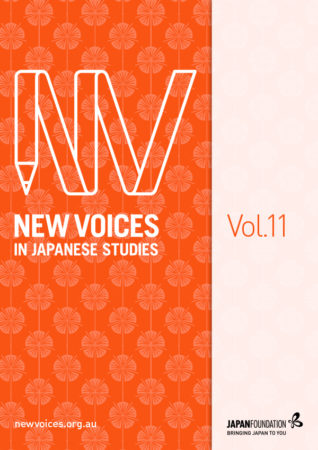By Emma Dalton (RMIT University)
Guest Editor, New Voices in Japanese Studies, Volume 11
The 11th edition of New Voices in Japanese Studies began as journal editions often do: as a nebulous collection of submissions by scholars from a range of disciplines at varying stages of their research careers. Eventually, the final version has somewhat organically formed around the broad themes of national identity and Japan’s position in the wider world since the Great East Japan Earthquake of 2011. Given the criticism sometimes levelled at the discipline of area studies as being excessively insular (a criticism that is arguably often justified in the field of Japanese Studies) this volume makes a welcome contribution to the field. Much has been made of Japan’s soul-searching since the triple disaster of March 2011. The collection of papers in this edition from scholars from law, sociology, creative writing and media studies adds to this robust and shifting conversation.
Atsushi Yamagata’s very readable article considers attitudes towards Muslim people in Japan. It provides intriguing insights into contemporary (mostly positive) attitudes towards Muslims, embedded in a fascinating history of Muslim presence in Japan. The world around Japan is experiencing the largest movement of people across borders ever seen—many of these people are those of the Muslim faith, escaping persecution or war. Against this backdrop, Japan’s entrenched reticence to the idea of opening borders to refugees and other immigrants invites scrutiny, particularly as the country struggles with its own socio-demographic problems of a rapidly aging society and shrinking workforce. Yamagata’s carefully considered analysis of media and existing survey results shows that Japanese society appears to be welcoming Muslims, which contrasts to high levels of Islamophobia seen elsewhere in the world. Yet, his paper suggests, this apparent welcome is extended with a caveat: Muslims, like many other immigrants to Japan, are expected to be temporary visitors rather than permanent additions to the Japanese populace.
Pepi Ronalds invites readers to consider the chasm between official government rhetoric of a hopeful, strong and unified nation preparing for the Tokyo 2020 Olympic Games and the material realities of those living in the Tohoku region—a region still in a process of recovery several years after it was struck by disaster. Drawing from interviews with those directly affected by the 2011 earthquake, tsunami and nuclear meltdown, Ronalds’ paper critiques Japan’s official message of hope, positivity and national cohesion expressed in glib Olympics propaganda and argues that victims of the 3.11 disaster feel removed from and alienated by these messages. The paper interrogates the justness of a discourse of the cult of the nation which diverts domestic and international attention and funds away from thousands of people whose lives remain fractured.
Evan Hamman’s paper speaks to Japan’s position in a rapidly changing and deteriorating socio-ecological world. The degradation of the natural environment is perhaps the most pressing issue of our time and we could be forgiven for regularly feeling an unsettling combination of impotence and panic upon hearing near-daily news reports pertaining to the planet’s imminent demise as a result of seemingly unstoppable human behaviour. Hamman’s paper about Japan’s wetland restoration efforts explores an area not often talked about outside specialist circles, but an area of significance for what it reveals about the health of our natural environment. The paper considers the way that Japanese grassroots movements engage with both supra-national level and national level policies, and suggests that Japan’s history of recovery from disasters combined with existing legal frameworks makes the country capable of leading the way in best practice wetland recovery.
Sonja Petrovic returns the readers’ attention to the events and aftermath of 3.11 and explores the role that social media played in creating a sense of community for people from varying geographical locations, including different parts of Japan and those outside the country as well. Based on interviews and analysis of social media data, Petrovic argues that social media can be used to foster a sense of belonging amongst people regardless of temporal or spatial differences in post-disaster contexts, thus potentially becoming a tool that helps people to cope better in case of disasters.
NVJS11 is the first edition to feature book reviews. It was a bit of a risk, as is any new venture, and it appears to have paid off. The three reviews in this edition by Levi Durbidge, Gwyn McClelland and Rebecca Hausler critically engage with texts that appear relevant and useful for research as well as teaching. While book reviews are a lot of work, they are usually worth the effort for what one learns in the process. I encourage anyone thinking about submitting a review to NVJS to do so.
I am honoured and deeply grateful to have been offered the role of Guest Editor for this volume. I would like to extend my sincere thanks to The Japan Foundation, Sydney, and in particular to Director Yoshihiro Wada for this invaluable opportunity. This occasion has led to some fantastic and capacious learning moments. I have learned much from the editorial process itself and also about the work of emerging Japanese Studies scholars in Australia. Working with Series Editor Elicia O’Reilly has been a lesson it what it means to be professional, warm, funny and efficient all at the same time. Elicia has been wonderfully alert and responsive and her level-headedness was an excellent tonic to my diplomacy short-comings.
Finally, I thank the contributors and reviewers for their patience and hard work in this process. Several submissions did not make it into this edition, but I hope to see them again as published articles in the next edition.
(July 2019)

